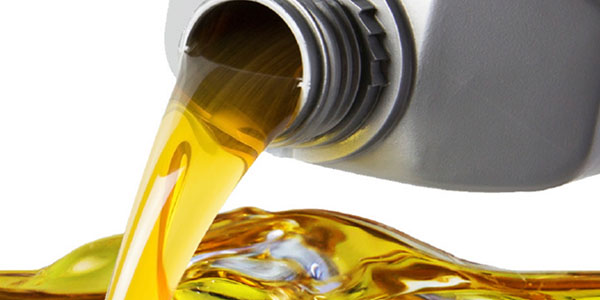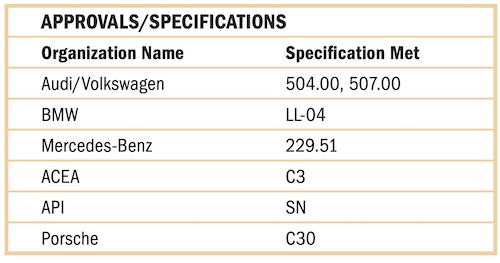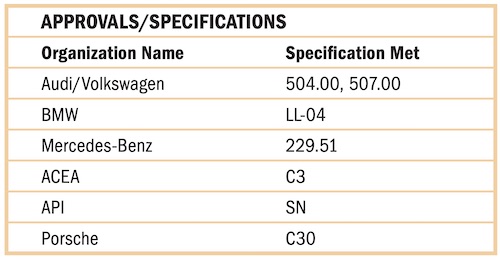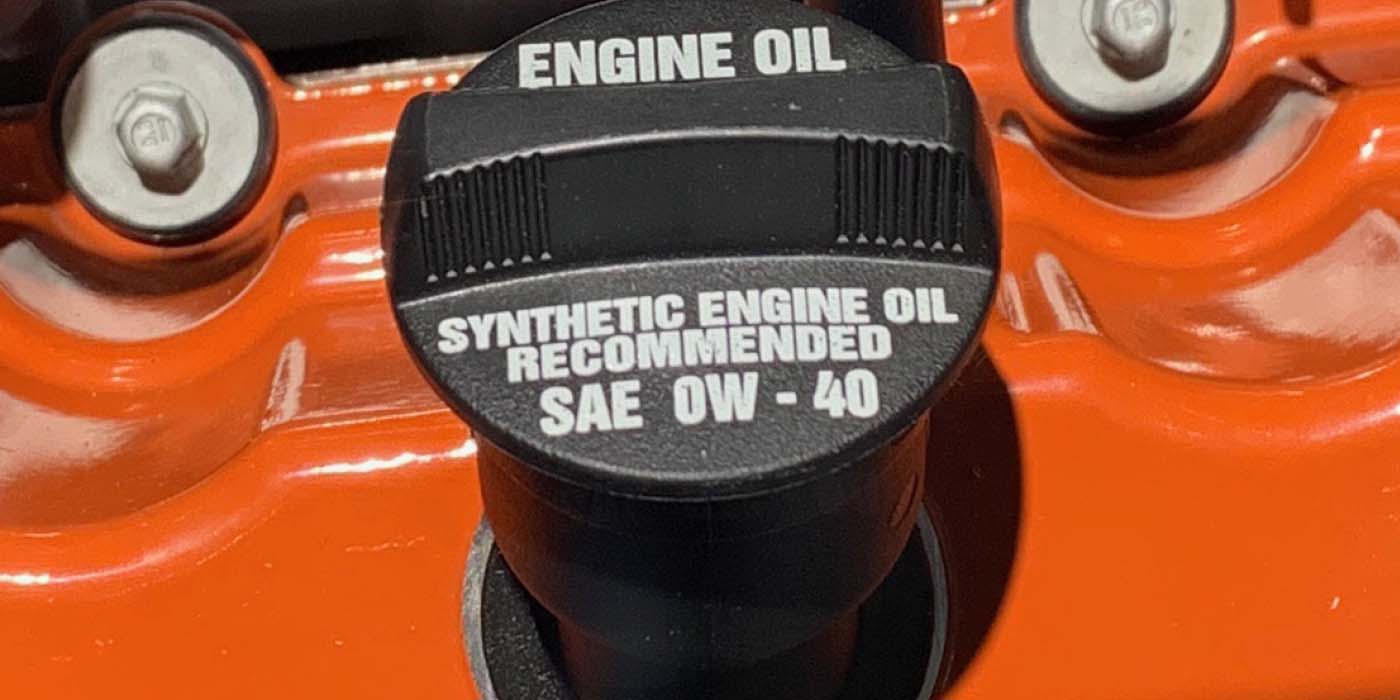A product data sheet for engine oil is like its birth certificate. On one or two pages is all the information to help you decide if the oil matches the specifications from the OEM. There are no standards for motor oil product data sheets, except that they consistently call them product datasheets.
There is a general flow of the information that typically starts with the name of the oil. After that might be a description of the oil written by the marketing department – this product description will list the applications for the oil.
The product data sheet starts with a listing of the basics, like appearance and part numbers. The next items cover laboratory measurements.

Pour Point: This is the lowest temperature (in °F or °C) at which a liquid remains pourable. Synthetic oils and lighter viscosities will remain pourable at lower temperatures.
Density: This is how much one cubic centimeter of the oil weighs at a specific temperature. This does not really serve as a way to determine the performance of the oil.
Noack: For this test, a sample is heated at 250 °C for 60 minutes with a constant flow of air over it. The weight fraction lost is the result. The lower the percentage lost, means that the oil is less likely to leave behind carbon deposits. Conventional oil will leave behind more residues because it uses a less refined base stock.
Viscosity Index: The viscosity index should not be used to compare oils because the number changes with the oil’s viscosity grade. It is a basic measurement of how the oil changes in viscosity. A 5W40 will have a higher viscosity index than a 5W20.
Flash Point: The flash point test is used to indicate the flammability of a lubricant. As the oil heats up, it can vaporize and catch fire. This can be used to compare different oils. A higher flash point indicates that an oil can withstand difficult conditions inside an engine without causing carbon deposits.
Viscosity CCS, HTHS and Kinematic: These tests are more for scientists and engineers. These tests are based on temperature and flow rates. Using these numbers to compare one oil to the other can be misleading.
API Ratings
Many oils have a new donut certification mark on the bottle called API SN-PLUS and SN-PLUS Resource Conserving. According to API, SN-PLUS standards are formulated to provide API SN performance and additional protection against low-speed pre-ignition for direct injection and turbocharging engines. SN-PLUS oils can effectively lubricate engines calling for API SN, API SN with Resource Conserving or ILSAC GF-5.
ILSAC Ratings
The International Lubricants Standardization and Approval Committee (ILSAC) is the gatekeeper of oil standards.
ILSAC GF -1,-2,-3,-4 and -5 are specifications for multi-grade oils that were first rolled out in 1992. GF-5 certified oils are compatible with the previous GF-1 to GF-4 oils of comparable weights.
The GF-5 requirements were rolled out in 2010. They were designed to provide improved high-temperature deposit protection for pistons and turbochargers, more stringent sludge control, improved fuel economy, enhanced emissions control system compatibility, seal compatibility, and protection of engines operating on ethanol-containing fuels up to E85.
Higher viscosity oils cannot meet an ILSAC GF-5 rating. The GF-5 rating corresponds closely to the API SN rating.
The ILSAC GF-6 specification is an improvement on the GF-5 specifications and addresses new engine technology like gasoline direct injection and turbocharging. Also, GF-6 introduces new lighter viscosities for automakers to help improve fuel efficiency.

When you look at a bottle of GF-6 oil, you might notice an “A” or “B” listed after the GF-6. GF-6A lubricants are backward compatible, meaning that GF-6A engine oils that are “legacy” viscosity grades are covered under GF-5. GF-6A oils can be used in older vehicles that call for GF-1 to GF-5. This means GF-6 covers most vehicles made after 1992.
The new GF-6B specifications are for new lighter weight multi-viscosity oils used by more modern vehicles. These oils are not backward compatible because of the new viscosity grades. GF-6B engine oils should only be used when recommended by the OEM (follow the owner’s manual) like 0W16. 0W8 is another planned viscosity that will be in the GF-6B category.
ACEA Rating
European car manufacturers are perhaps the most focused on extended interval oil options, and these manufacturers abide by the standards set by the European Automobile Manufacturer’s Association (ACEA). These standards are based on testing developed by the European Engine Lubricants Quality Management System (EELQMS).
“A” and “B” (1-5) rated oils are stable, stay-in-grade oils intended for use at extended drain intervals in gasoline and diesel engines (car and light van). These are specifically designed to be capable of using low-friction, low-viscosity oils with a high temperature/high shear (HTHS) rate viscosity.
The “C” rating designation is for catalytic converter-equivalent oils. They are A5/B5 oils with a low sulfated ash, phosphorous and sulfur content.
Manufacturer Ratings
On the product datasheet, will be the OEM specifications the oil meets. This is worth looking at because many bottles do not have room to list all the specifications. Often, the sheet will list legacy or obsolete specifications for an oil.
BMW has only three oil specifications — BMW Longlife-98, BMW Longlife-01 and BMW Longlife-04. These oils typically meet and exceed ACEA and API SJ/CD standards.
BMW Longlife-04 oils require special BMW approval for fully synthetic long-life oil. Longlife-04 is backdate compatible where Longlife-98 or BMW Longlife-01 is recommended.
Chrysler has three proprietary oil specifications for gasoline engines. They call these standards Chrysler Material Standards or MS specifications. The MS specification for the vehicle depends on the specified viscosity, engine technology and when the car was manufactured.
Ford structures oil specifications around the weight of the oil and engine technology like diesel and turbocharger technologies. Ford uses the acronym WSS for engine oils.
GM Dexos1- approved oils are recommended for all 2011 and newer GM vehicles with gasoline engines. Dexos1-approved oils are designed to work with the oil life system in GM vehicles. These oils are designed to reduce carbon deposits in the combustion chamber that can occur in some Ecotec engines.
GM revised Dexos1 specifications in 2015. Oils that meet this standard are often labeled Dexos1 Gen2, but many oils do not include the Gen2 on the label due to confusion with Dexos2 oils for diesel engines. Dexos1 Gen2 oils are formulated to reduce incidents of low-speed pre-ignition (LSPI).
Honda, Nissan and other Asian OEMs like to stick with ILSAC and API specification for oil. Most will stick with GF-5 grade oils. But, many have API SN-Plus grade oils while GF-6 oils are being approved and distrubuted.
Some Asian manufacturers are using more turbochargers, and you may run into vehicles that require 10W30, but the non-turbocharged version might call for a 0W16 oil.









